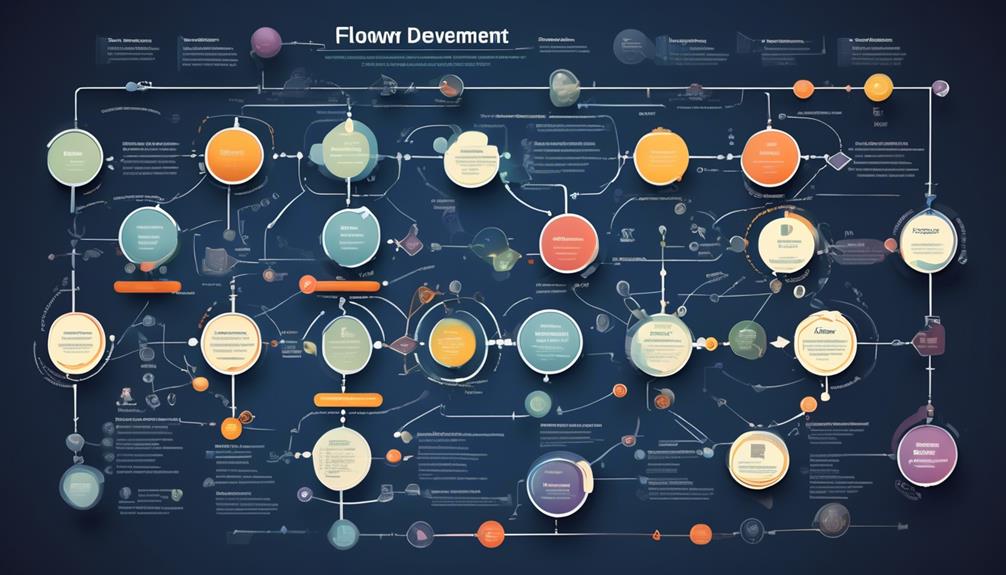As software development becomes more intricate, there could be concerns about the significance of integrating Software Quality Assurance (SQA) across the whole lifecycle. However, we are confident that implementing effective SQA practices is crucial for ensuring the reliability and performance of software products.
From initial requirements analysis to final product release, SQA is essential for identifying and addressing potential issues at every stage of the development process. By understanding how SQA fits into the larger software life cycle, we can better appreciate its impact on product quality and customer satisfaction.
Let's explore the ways in which SQA influences the development process and the benefits of a well-integrated SQA program.
Key Takeaways
- SQA plays a critical role in identifying inconsistencies, errors, and redundancies in software.
- Integrating SQA within each phase of the development process enhances the overall quality and reliability of the software product.
- The roles and responsibilities in SQA teams include defining testing strategies, identifying errors, and collaborating with the testing team.
- Upgrading the SQA program improves efficiency, customer satisfaction, and ensures that the software meets company standards and expectations.
Importance of SQA in Software Life Cycle
In the software life cycle, the importance of Software Quality Assurance (SQA) can't be overstated as it plays a critical role in identifying inconsistencies, system errors, and feature redundancies. SQA is integral to the Software Development Life Cycle (SDLC) as it ensures that the product meets high-quality standards and user expectations.
Through meticulous testing and planning, the SQA team meticulously evaluates the software at various stages of development to detect and rectify bugs, thereby preventing major failures in production applications. This proactive approach not only safeguards the brand value from poor user experience but also reduces potential revenue loss due to system defects.
Furthermore, SQA contributes significantly to improving customer experience by ensuring a user-friendly interface and meeting company standards. By incorporating SQA into the development process, the team can enhance customer satisfaction and prevent expensive mistakes that could harm the company's reputation.
Ultimately, SQA is vital for ensuring the final quality of the software product and is an indispensable aspect of the overall development process.
Integrating SQA in Development Stages

Integrating SQA in the development stages involves meticulously aligning the quality assurance process with each phase of the software life cycle, ensuring thorough evaluation and rectification of potential issues, and ultimately enhancing the overall quality of the software product. The role of QA is pivotal in the software development process, with specific responsibilities tailored to each phase. During the planning phase, QA plays a critical role in identifying potential issues with user experience, ensuring that the software meets user expectations. In the implementation phase, QA follows a component testing approach to verify the functionality of individual modules and components. As the software nears completion, QA ensures smooth deployment and verifies that all features and functionalities work as intended. Throughout these phases, QA specialists create and implement strategies for software quality improvement, planning the testing process and objectives. This meticulous integration of Quality Assurance within each phase not only ensures the identification and rectification of potential issues but also serves to enhance the overall quality and reliability of the software product.
| Phase | Role of QA | Software Testing |
|---|---|---|
| Planning | Identify potential user issues | Usability and requirements |
| Implementation | Component testing | Module and component testing |
| Deployment | Smooth deployment verification | Feature and functionality |
Roles and Responsibilities in SQA Teams
With meticulous attention to detail and a methodical approach, the roles and responsibilities within SQA teams are essential for ensuring the quality and reliability of software products.
The Quality Assurance (QA) team plays a crucial role in the testing process, encompassing various responsibilities such as defining testing strategies, setting up the testing stage, and executing quality control measures. Software testers, as part of the QA team, are accountable for identifying inconsistencies and errors within the software.
QA engineers contribute to preventing failures and avoiding brand damage by ensuring thorough testing and adherence to quality standards. The QA role also involves collaborating with the testing team to establish clear requirements and expectations, maintain open communication, and manage issue resolution processes effectively.
Furthermore, offshore team management is vital to the adaptation of processes for offshore teams, necessitating the distribution of workload based on complexity and the adaptation of issue management processes.
Upgrading the SQA program benefits not only the team but also the customer, with improved experiences, increased satisfaction, and prevention of mistakes, ultimately leading to time savings and enhanced user engagement.
In-House Vs Outsourced QA Teams

Drawing from the meticulous attention to detail and methodical approach of SQA teams' roles and responsibilities, the comparison between in-house and outsourced QA teams reveals distinct advantages and considerations for software quality assurance. The decision to move forward with either in-house or outsourced QA teams should be based on several factors, including the specific needs of the project, the expertise required, and the available resources. We have summarized the key considerations in the table below:
| Consideration | In-House QA Teams | Outsourced QA Teams |
|---|---|---|
| Control and Oversight | ✓ Provide better control and oversight of the QA process | ✗ Less control and oversight, but more scalability |
| Collaboration and Communication with Dev Team | ✓ Foster stronger collaboration and communication with dev team | ✗ External perspective, less direct collaboration |
| Cost-Effectiveness | ✓ Can be more cost-effective for long-term projects | ✓ Cost-effective for short-term or one-time projects |
| Flexibility and Adaptability | ✓ Offer greater flexibility and adaptability to project changes | ✓ Offer scalability to match project demands |
Ultimately, the choice between in-house and outsourced QA teams depends on the project's specific requirements, budget, and timeline. Whether it's ensuring expert input on user experience or saving significant time and resources, the decision should prioritize maintaining high standards of software quality.
Advantages of Upgrading SQA Program
Upgrading the SQA program significantly enhances efficiency and customer satisfaction through standardized processes and automation. By implementing an upgraded SQA program, the QA teams can streamline the QA testing approach, leading to improved product development and higher assurance in the software's quality. This upgrade ensures that the software meets company standards and customer expectations, thereby increasing overall customer satisfaction. Moreover, an enhanced SQA program can prevent expensive mistakes and safeguard the company's reputation.
The importance of quality assurance in the software can't be overstated, and an upgraded SQA program plays a pivotal role in achieving it.
Consideration of hiring QA specialists, augmenting the in-house team, or outsourcing QA work is crucial in upgrading the SQA program. These decisions should be made in alignment with the specific needs of the organization and the nature of the software being developed.
Frequently Asked Questions
What Is the Life Cycle of a Quality Assurance System?
The life cycle of a quality assurance system involves planning, designing, executing, and evaluating processes to ensure high standards of product quality.
Our team meticulously oversees each phase, identifying potential issues, implementing corrective measures, and continuously improving our procedures.
We focus on maintaining rigorous standards and staying adaptable to the evolving needs of our products and customers.
Our attention to detail and methodical approach ensures a comprehensive and effective quality assurance life cycle.
What Is Software Quality Assurance in Software Engineering Life Cycle?
In software engineering life cycle, software quality assurance involves evaluating and monitoring the entire development process to ensure that the end product meets specified quality standards. It encompasses testing, bug tracking, and continuous improvement to guarantee a robust, reliable, and user-friendly software.
Our team diligently oversees each phase, actively identifying and addressing potential issues, ultimately contributing to the delivery of high-quality software products.
What Is QA Role in Sdlc?
In the software development life cycle, QA plays a crucial role in ensuring quality by:
- Identifying potential issues
- Providing insights on implementation methods
- Writing detailed test cases
We prioritize supported browsers and devices, ensuring a seamless user experience. Additionally, we:
- Verify that all features work as intended during deployment
- Provide ongoing support for bug fixes and updates
Our involvement spans across:
- Planning
- Design
- Implementation
- Testing
- Deployment
- Maintenance phases
This ensures a high-quality end product.
Where Does QA Fix in the Software Development Life Cycle?
In the software development life cycle, QA fits into various stages.
We collaborate with developers during planning to reduce testing time.
In the design phase, we identify gaps in designs.
During testing, we write test cases and file bugs.
We ensure smooth deployment and provide ongoing support for bug fixes in the maintenance phase.
Our role extends beyond the post-release stage, ensuring integration into all development stages.
Conclusion
In conclusion, integrating SQA in the software development life cycle is essential for delivering high-quality software.
Did you know that companies that prioritize SQA experience 25% fewer post-release issues? This statistic highlights the importance of investing in a robust SQA program to ensure customer satisfaction and prevent costly post-release problems.
By continuously improving the development and testing process, SQA teams play a critical role in the success of software projects.









